
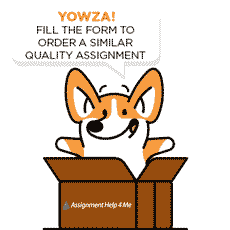
Target’s structured & insightful business evaluation
Isabelle Taylor | 11 Sep,2021
Introduction
The key purpose of this article is to evaluate the growth of the Retail Industry of the US and to determine the strategies that can be implemented by Target Corporation to improve its competitive position. In this strategic analysis article, you will get to know about the internal and external market condition of Target Corporation as various strategic analysis tools have been used to meticulously evaluate the internal and external market effectiveness of Target Corporation. Further, competitive analysis through the use of Porter’s Five Forces framework is also performed to evaluate the competitive position of the company. Further, on the basis of various internal and external market analyses, various recommendations have been provided to improve the competitive position of Target Corporation in the market.
Target company profile
Target Corporation is the eighth largest American retail chain in the US that operates more than 1900 stores in 50 states (Fortune, 2021). The Target Corporation has also been established as the discount division of Dayton's company since 1962. Further, the Target Corporation is also ranked at the 37th position on the Fortune 500 list (2020) featuring the largest US corporations in terms of total revenue.
History of Target
Target Corporation is an American retail company that was founded in 1902 by George Dayton as Good Fellow Dry Goods. However, in the following year, the name of the company was changed to Dayton Company in 1911, and in May 1962, the first store of Target was opened as the discount version of Dayton departmental stores. By the end of 1975, Target Corporation had become Dayton's leading revenue producer and by 1979, the Target store had achieved sales of $1 billion. Since then, the company has focused on its target stores, and to reflect a higher focus on target stores, Dayton Hudson changed its name to Target Corporation in 2000. By the end of the 20th century, the company also had distinguished itself from its competitors by offering stylish products at affordable prices. In 2012, the company also opened its first city target store with the aim to effectively meet the needs of the urban customers (Target, 2021).
Target mission and vision statement
The mission of Target is “to make Target the most preferred shopping destination for the buyers through outstanding services, continuous innovation, and exceptional guest experiences”. The mission statement of Target Corporation also supports higher expectations and pay less which helps to better meet the needs of the diverse customers. The vision statement of the Target Corporation is “guided commitment to greater value for the community, diversity, and environment” (Samuel, 2021).

Retail industry analysis- Target Industry analysis
The retail industry is growing at a very fast pace due to the increasing population. Further, the US retail sales have increased by 15.8 % in July 2021 as compared to 18.6 % in the previous month. Further, the US sales reached an all-time high in April 2021 i.e. 42.7 % which is shown as follows-
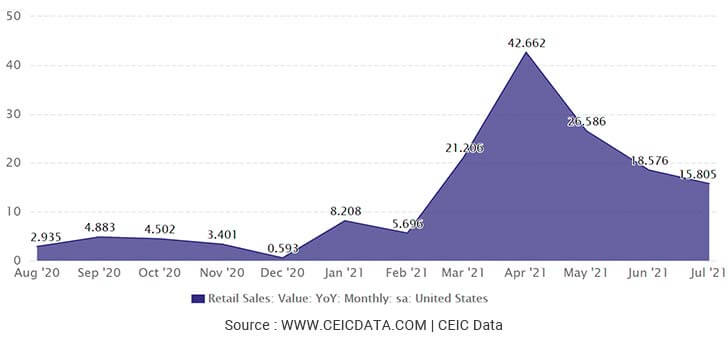
Further, the US has well-established distribution channels which further help to foster the growth of the retail companies. The well-established distribution network in the US also provides strong opportunities for growth to the businesses. The US retail industry earned a revenue of USD 5.4 trillion in 2019. Also, the health and beauty sector achieved the highest share in terms of retail sales. The primary players in the market include Walmart, Costco, Target, Kroger, and Home Depot (Allianceexperts, 2021). However, the foreign brands in the industry make it very challenging for the local retail companies to penetrate the market. Along with this, the use of mobile devices is further supporting the growth of online retail companies. However, the majority of retail sales are still in-store and e-commerce only accounted for 13.6 % in 2021. Further, the expected growth rate of the retail industry is exhibited below.
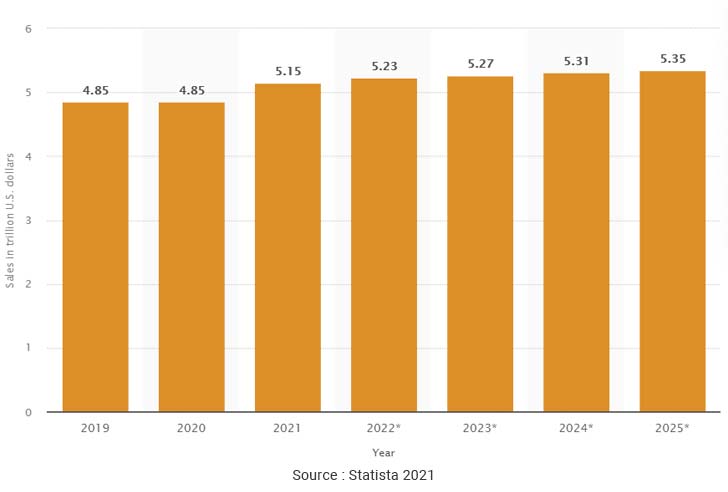
The above figure shows that retail sales in the US are rising significantly and it is expected that the retail sales in the US will rise to $ 5.35 trillion by the end of 2025. However, the consumers spent $ 861.12 billion in 2020 while buying online from US merchants. The following figure shows the proportion of e-commerce sales to the total sales in the US.

The above figure shows that e-commerce sales in the US have increased over the period of time and COVID-19 is one of the major reasons that has boosted online sales. The top online retailers in 2020 are shown as follows-

Thus, it is found that Amazon has achieved huge significance in the online retail market. Also, Walmart is surpassing Apple Inc. for the first time. Not just this, Target Corporation is currently ranked at the 12th position in terms of online retail sales but in 2021, Target Corporation is also expected to be listed among the top 10.
Target core values
The core values of the target include team culture, doing the right things, delivering on promises, and keeping everything simple. Target Corporation also focuses on celebrating diversity and inclusion as well as community and employee engagement to create an open work culture and conducive environment for all the employees in the organization.
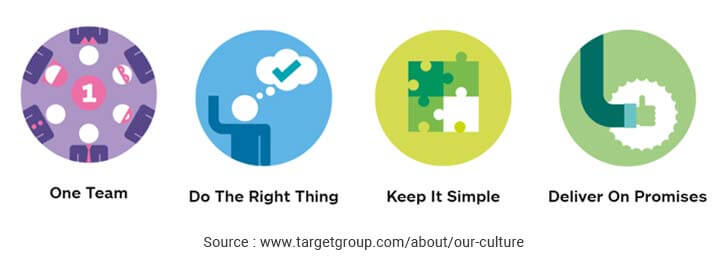
Target external analysis
The external market of Target Corporation can be evaluated by applying the external analysis framework and competitor analysis tools. Thus, in this section, the PESTEL and Porter Five Forces analysis frameworks are applied to evaluate the external environment of Target Corporation-
Target PESTEL analysis
PESTEL analysis is an important external market analysis framework which helps to analyse the external market factors relevant to the organization. The PESTEL analysis of Target Corporation is performed as follows-
Political factors
One of the major political factors that is impacting the growth of Retail Industry in the US is the US-China trade war which has resulted in increased trade tariffs. The future of the global supply chain is also uncertain due to change in the US trade policies as well as the impact of the US China war on the supply chain practises. Further, the trade volume of the US and China is also negatively impacted amid the US-China trade war (Lee, 2020). However, the US has agreed to call off some of the threatening tariff increases on various Chinese products such as tools, toys, and cell phones with the promises of increased US agricultural goods export to China. Lack of compliance with these promises by China can also lead to re-implementation of tariffs on different goods which further leads to increase in cost and retail price of various goods. The US also has a bilateral trade relationship with Afghanistan but with the latest geopolitical developments in Afghanistan, it is expected to have a negative impact on the overall trade of the United States with a decline in the total imports and exports to Afghanistan. This further is expected to have a huge impact on the total US economy and growth of businesses (Ustr.gov, 2021).
Economic factors
The drastic changes caused by COVID-19 had a huge impact on the growth of the Retail Industry as the COVID-19 crisis caused stark contrast in the business operations due to lock down restrictions and changing the purchase behaviour of the customers. However, the US GDP in the current time has increased at an annual rate of 6.6 % in the second quarter of 2021 which reflects the continued economic recovery and opening of the establishments that is one of the positive factors for the growth of the Retail Industry in the US (Cox, 2021). The growth of the US GDP is shown as follows-
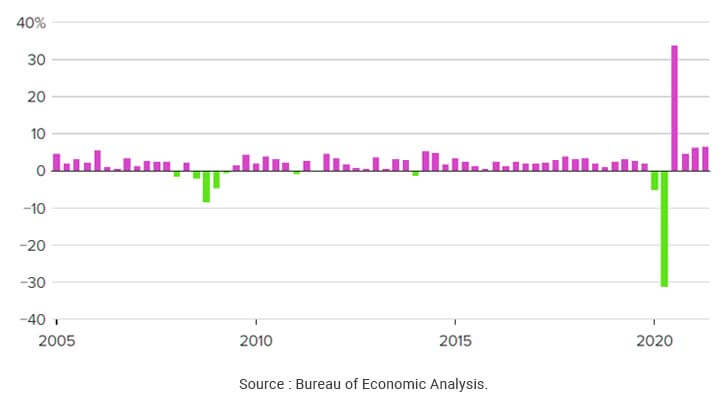
The above figure shows that the GDP is increasing in current times and the economic recovery is also expected to influence the growth of the retail industry. Despite this the personal disposable income of the customers is also rising in the US and has increased from 17850 USD billion to 18048 USD billion in June 2021.
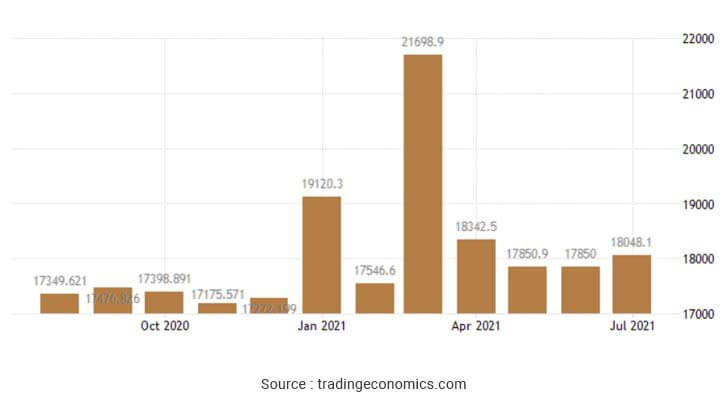
Not just this, the sales of the retail industry have increased by 15.8 % since the last year with an increase in customer spending and online sales (AMADEO, 2021).
Social factors
Change in customer preferences is one of the major factors that is influencing the growth of retail companies. The outbreak of COVID-19 also has resulted in an increasing trend of digital shopping and this trend is also expected to continue in the future due to rising sales from e-commerce channels in the post-COVID-19 period. The expected growth in the number of customers purchasing various products and services over the digital channels is depicted in the below illustration.

Thus, the trend of digital shopping is found to be highest among millennials and people in high-income groups. Not only this, the affordability of various products and services of retail companies like Target is also influencing the digital shopping trends. The population of the United States in 2019 was 329,064,917 in 2019 which will increase by 0.58 % in 2020 reaching 332,915,073. The rise in the population rate of the country is also influencing the growth of retail sales (Macrotrends, 2021).
Technological factors
Technological advancement is one of the major factors that is influencing the growth of the Retail Industry as the use of various technologies such as the internet of things (IoT), autonomous delivery, drones, delivery robots, and cashless stores help to improve customer convenience and accessibility at different stores. Further, retail companies like Target Corporation are also focusing on booming their online businesses through new technologies to further establish a strong competitive position in the industry. Moreover, the company also aims to facilitate the same-day delivery of online orders to the customers to further promote customer convenience in digital shopping. However, it is a must to consider that the use of various technologies by competitor firms as drones, face recognition technology, and cloud computing provides strong competition to Target. Furthermore, Target Corporation is also partnering with Shipt, an online delivery service company to facilitate same-day delivery of the goods to the customers through in-store pickup.
Environment factors
It is a must to consider that the customers in the current times are becoming more environmentally conscious which requires the organizations to comply with various environmental responsibilities to promote environmental sustainability. However, various retail companies use chemicals in their manufacturing processes which are not only harmful but also lead to various negative impacts on the environment. The use of fossil fuels is another major issue in the retail sector as fossil fuels lead to higher GHG emissions. Moreover, the focus of the companies on same-day delivery of goods has increased the need for transportation of the goods. However, to mitigate the negative impact on the environment, the companies are also implementing various sustainable policies and practices. Target Corporation also focuses on responsible sourcing and product investigation procedures to reduce GHG emissions and accelerate circular systems for protecting and sustaining nature. Furthermore, various retail companies like Target have also installed rooftop solar systems and energy-efficient light fixtures to further improve their brand image and competitive position in the industry (MINNEAPOLIS, 2021). In addition to this, the retail companies are also promoting the use of biodegradable packaging to eliminate plastic waste in the environment and to comply with various regulatory requirements in the manufacturing sector.
Legal factors
Various laws and regulations impact the working of the retail businesses in the US and the Consumer Protection Act, section 5 of Federal Trade Commission Act, and 16 CFR Part 435 or mail order rule requires that the consumers should be protected from unfair trade practices (Imrg, 2021). Not just this, the FTC mail order rule also requires that the organization should have a reasonable basis to determine the shipping period of the goods advertised. Along with this, various other laws such as the Data Protection and Privacy Act, Occupational Safety and Health Act 1970, Fair Labor Standards Act of 1938, etc. also regulate the working of the retail companies. The retail firms are also required to pay fair minimum wages to the employees to comply with various labor standards and to maintain employee satisfaction.
Target Porter five forces analysis
The Porter five forces analysis is an important holistic framework that helps to evaluate the competitive position of the organization. The Target Porter five forces analysis is performed as follows-
Threat of bargaining power of suppliers
The bargaining power of suppliers of Target is very low due to the presence of a large number of suppliers and tough competition between the suppliers. Target sources its products from more than 3696 manufacturing facilities. Further, the product differentiation is very low in the case of the retail industry which further reduces the bargaining power of suppliers in the industry. The individual suppliers of Target such as Cisco Systems, Vornado Realty Trust, Dillard's Inc., etc. have little influence on the supply of Target (Csi, 2021). Thus, the bargaining power of suppliers is very low and the Target Corporation is in a position to negotiate with a large number of suppliers.
Bargaining power of buyers
The bargaining power of buyers in the industry is moderate as affordable and differentiated products and service offerings of Target minimized the bargaining power of buyers. However, the products in the retail industry are very price-sensitive due to the presence of large retail companies in the industry which increases the bargaining power of the customers to a certain extent. Also, the low switching costs of the goods for buyers provide bargaining power for the buyers in the industry.
Threat of substitute products
The threat of substitute products is very high in the retail sector due to the presence of various retail companies such as Wholesale Clubs, Amazon, Home Depot, Best Buy, etc., and lack of differentiation between the products and services. Further, the needs of the customers can also be met in different ways which further increases the threat of substitute products. However, Target Corporation tries to eliminate this threat through differentiation and affordable pricing strategies.
The threat of new entrants
The threat of new entrants in the Retail Industry is very low due to the need for huge capital investment and the difficulty of the new firms to establish economies of scale in the industry. The existing form in the retail sectors such as Target enjoys a low-cost advantage due to higher economies of scale which provide a strong competitive advantage to the firm. Moreover, the Exclusive partnership of various firms such as Walmart and Target with the suppliers further reduces the threat of new entrants in the industry. The customers have also developed strong brand preferences for the existing firms in the industry which also has resulted in reduced threats of new entrants.
Rivalry among the existing firms
The rivalry among the existing firms in the retail sector is very large due to the presence of large competitor firms such as Walmart, Costco, Whole Foods Market, Amazon, etc. The high rivalry among the existing firms can also force down the price as well as the profitability of the retail firm. However, the mission of Target i.e. “Pay less, expect more” depicts the cost leadership strategy of the company.
Target competitors
Target is a discount retail store that generates revenue by offering competitively priced and differentiated products and services to the customer. The main competitors of Target include Walmart, Costco, and Amazon. Target Corporation mainly appeals to customers through high-quality merchandise with low designer fashion items. Walmart also emphasizes low price shoppers by offering low-priced goods to customers. In addition to this, Costco Shoppers are more affluent as compared to the Target and Walmart customers. Target Corporation undertook various measures to improve its delivery services in December 2017 by announcing the purchase of Shipt, an online delivery company (KUANG, 2020). The Other main competitors of Walmart include Home Depot, Kroger company, Kmart, Best Buy, etc. (Bhasin, 2018).
Target competitor’s analysis
To evaluate the competitive position of Target, it is necessary to perform the competitor analysis of Target Corporation. Thus, the competitor analysis of Target is performed as follows-
| Competitors | Revenue in 2020 (USD) | Number of stores | Earnings per share (US $) |
|---|---|---|---|
| Target | 93.56 billion | 1904 stores | 6.36 |
| Amazon | 386.064 billion | 589 stores | 41.83 |
| Walmart | 130.377 billion | 4756 stores | 1.26 |
| Best buy | 42.88 billion | 956 stores | 5.75 |
| Costco | 166.76 billion | 804 stores | 9.02 |
The above competitor analysis of firms in the retail sector helped to determine that Amazon has achieved the leading position in the retail industry due to its strong online presence and customer loyalty. However, it is found that the number of stores of Target must be higher than the number of stores of Amazon, Best Buy, and Costco. Further, the operating margin of different retail firms is compared as follows-
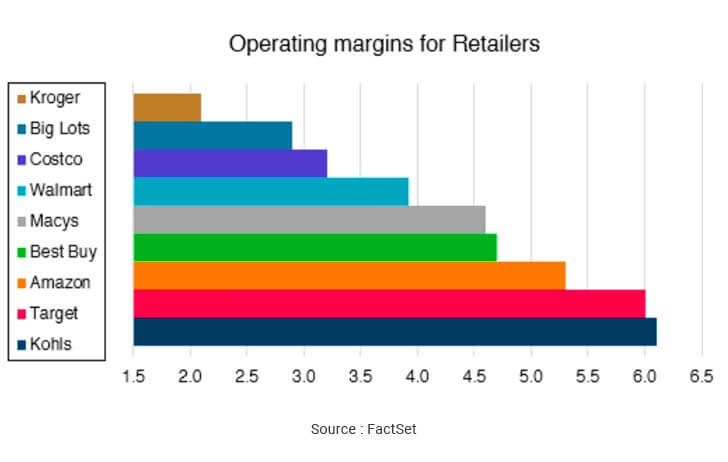
The above figure depicts that the operating margin of Target is still higher than the operating margin of Amazon, Best Buy, etc. The operating margin of Kohls’s is also only slightly higher than that of Target. Further, to deal with huge competitive pressures, the company has implemented free delivery services where the company aims to offer free delivery of goods for orders above $ 25 which was previously $ 50. Now, Target has the lowest threshold for the free delivery of orders. Also, Amazon requires the customers to purchase for a minimum of $ 35 to be eligible for the free delivery of the orders. The following figure shows the minimum order value required for the free shipping of the orders-
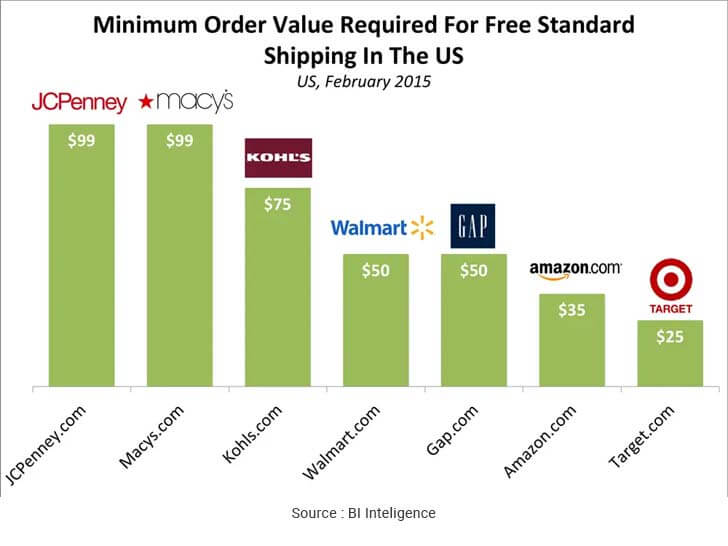
The above figure shows that among the top retail companies in the US, Target Corporation has the lowest minimum order value eligible for the free shipping of the goods (Smith, 2015).
You can read about some competitors of Target USA here:
Amazon
Target competitive strategy
We all know that Target is fighting two major struggles i.e. one against the online retail company i.e. Amazon and the other against the brick-and-mortar store i.e. Walmart. However, Target has implemented various strategies in recent times with the aim to compete with various large firms. The main strategy of Target in the current times is effective positioning as Target Inc. has narrowed down its focus on the young families by offering low prices and differentiated products and services to the customers. The major competitor strategy of Target is of a huge investment in technological improvement where the company aims to raise its capabilities of providing high quality and better services to the customers. Further, the acquisition of Shipt, an online delivery company also provides the opportunity for Target to offer same-day delivery of goods to customers. Not just this, Target Corporation is also achieving a strong competitive position in the market by launching new product lines as diversified product lines help the company to achieve a strong competitive position in the market.
Target positioning analysis
Target is an American retail company that has established a strong brand image in the USA for its high-quality products and services. The company has also established the position of a low-cost store due to various discounts being offered to customers. The tagline of Target i.e. “Payless, Expect More” further helps the company to position itself as a brand with high quality and low price product offerings. The positioning map of Target is prepared as follows-

Thus, it is found that Target offers high-quality retail products to customers at low prices. Furthermore, the company also has established the image of elegant and economical stylish products in the market.
Target internal analysis
Target financial analysis
Target revenue analysis
The revenue of Target Corporation is rising in the current times and the outbreak of COVID-19 further accelerated the sales of various essential products and services. The revenue growth of the company over the period of time is shown as follows-
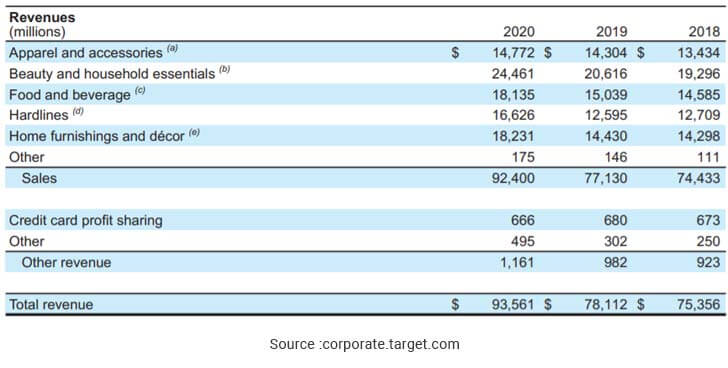
The above revenue analysis of the Target Corporation shows that the revenue of the Target Corporation increased from $78112 million to $93561 million due to an increase in the overall sales of various products and services. Further, the revenue from the sale of beauty and household Essentials increased from $ 20,616 million to $ 24,461 million which shows a rise in demand for various beauty and household essential items in the COVID-19 period. The demand for food and beverages also showed a greater rise as the revenue of the food and beverage segment of the company was $ 15039 million which was increased to $18,135 million in 2020.
Target profitability
In addition to the increased revenue, the profitability of Target Corporation has also increased significantly and the net operating profit after taxes of the company increased from $ 3708 million on February 1, 2020, to $ 5206 million on January 30, 2020. The change in the operating profit after taxes of the company is illustrated below-

However, the gross margin rate of Target Corporation has declined from 28.9 % to 28.4 % from 2019 to 2020 which is shown underneath-
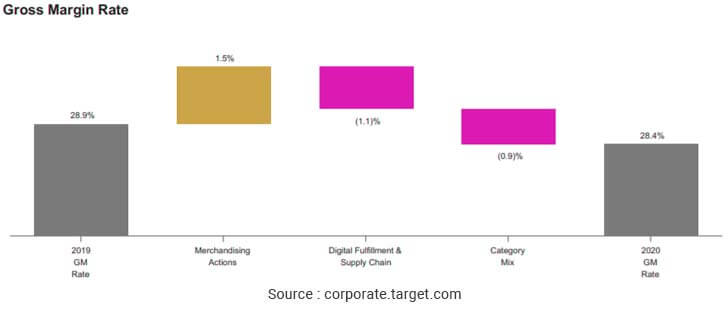
The decrease in the gross margin of Target Corporation is the result of increased digital fulfillment and supply chain costs of the company.
Target VRIO analysis
VRIO analysis is an important analytical technique that helps to evaluate the core resources and capabilities of an organization. The VRIO analysis of the company is performed as follows-
| Resources and capabilities | Valuable | Rare | Inimitable | Organized | Competitive advantage |
|---|---|---|---|---|---|
| Brand name | Yes | Yes | Yes | Yes | Permanent competitive advantage |
| Financial resources | Yes | Yes | Yes | Yes | Permanent competitive advantage |
| Yes | Yes | Yes | Yes | ||
| Supply chain network | Yes | Yes | Yes | Yes | Long term competitive advantage |
| Intellectual property | Yes | Yes | No | No | Temporary competitive advantage |
| Distribution channel | Yes | Yes | Yes | Yes | Long term competitive advantage |
| Technological advancement | Yes | Yes | Yes | No | Unused competitive advantage |
| Relationship with wholesaler and retailers | Yes | Yes | Yes | Yes | Long term competitive advantage |
| Product portfolio | Yes | No | No | Yes | Competitive parity |
| Human resource management | Yes | Yes | Yes | Yes | Long term competitive advantage |
| Digital strategies | Yes | Yes | No | Yes | Temporary competitive advantage |
| Owned brands | Yes | Yes | Yes | Yes | Long term competitive advantage |
| Guest service experience | Yes | Yes | Yes | Yes | Long term competitive advantage |
Target Non-Core Competencies and Competitive Disadvantage
The areas of non-core competencies of Target include intellectual property and poor digital strategies. The intellectual property of Target is also an area of non-core competency and the principal trademarks of the company only include its tagline “expect more, pay less” and bullseye design. In addition to this, the company has focused only on limited digital marketing strategies which is a source of competitive disadvantage for the company given the immense scope of digital marketing and advantages of social media for brand engagement.
Target core competencies
The product portfolio is one of the major areas of core competency as the company is known for selling a wide assortment of general merchandise and food products. Target has employed over 4,09,000 full-time, part-time as well as seasonal team members to manage its operations more effectively. The company also focuses on hiring diverse members to promote inclusive work culture. Furthermore, the continuous learning program of the company, leadership opportunities, coaching, and mentoring sessions help to ensure higher satisfaction of the employees at the workplace. The compensation package of the company also includes minimum wage pay of $15 per hour and the company has implemented various workplace health and safety programs to ensure higher health and safety of all the employees.
The General Merchandise stores of the company also offer food assortments such as perishables, frozen items, dry grocery, and dairy products. Furthermore, one-third of the total sales of the company come from its own and exclusive brands. The list of the owned and exclusive brands of the company are shown as follows-
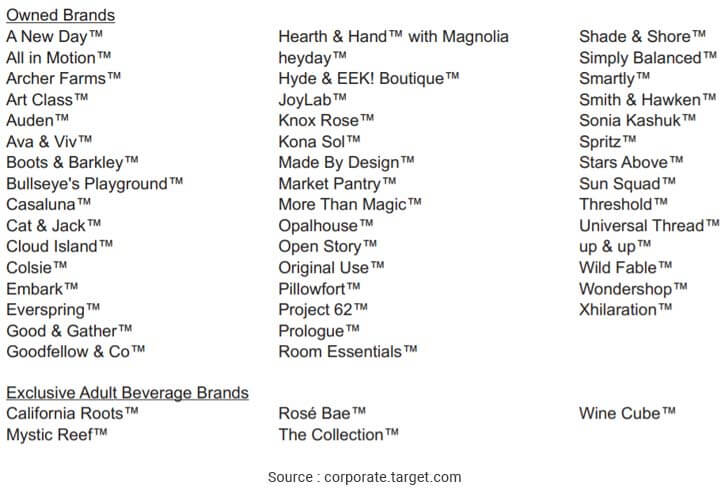
Besides this, the company also partnered with Ultra Beauty in 2020 to offer a shop-in-shop experience for the customers on target.com. The customer loyalty programs of the company such as a 5% discount on all purchases and free shipping on various cards such as target credit card and target MasterCard also help to attract various customers. The distribution network of the company is also very extensive which helps the company to achieve a strong competitive position in the industry. A large number of third-party distributions offer their food items and other mechanical products directly to the company stores. The company also sells the merchandise to the customers through digital channels which are delivered to the customers through online delivery services such as order pickup and Shipt delivery services (Corporate, 2021).
Target core resources and capabilities
The core resources and capabilities of Target include Human resource management, marketing, customer loyalty, strong product portfolio, effective distribution network, strong supply chain, etc. The acquisition of Shipt, an online delivery service company also has improved the service delivery capability of the company as it helps to facilitate same-day delivery of goods to the customers. In addition to this, a strong brand image and customer loyalty also help Target to ensure repeated purchases by the company. Also, effective inventory management is another important area of the core resources and capabilities of Target that helps the company to facilitate easy replenishment of the stock.
Target SWOT analysis
SWOT analysis is an important strategic analysis technique that helps to analyze the strengths, weaknesses, opportunities, and threats of the organization. The SWOT analysis of Target Corporation is performed as follows-
| Strengths | Weaknesses |
|---|---|
|
|
| Opportunities | Threats |
|
|
Target business strategy analysis
The key strategy adopted by Target Corporation is product diversification where the company aims to effectively meet the needs of all customers. The main aim behind the product diversification strategy is to offer a one-stop shopping destination to millions of customers. The company also has Louisiana implemented low-cost strategies to provide goods to customers at affordable prices. In addition to this, Target Corporation is also undertaking various strategies to enhance the convenience in the shopping experiences of the customers. Not only this, but the company also has expanded its drive-up services across South Carolina, Alabama, Georgia, Louisiana, etc. to facilitate pickup services for the customers (MINNEAPOLIS, 2021).
Target business model
The company is building on the aspects of the differentiated model to facilitate a one-stop-shop for millions of customers. Target also runs large stores with a focus on low-cost retail strategies with the aim to achieve higher profit margins with higher sales. The inventory turnover ratio of Target is very low which helps in providing high-quality goods and services as per the new trends to the customers. The company also utilizes a low pricing strategy similar to other retail firms such as Walmart and Amazon to achieve a strong competitive position in the industry. Moreover, Target Corporation has differentiated its business model from various other retailers in the industry by creating a large portfolio of private label brands (MIRZAYEV, 2019). Furthermore, Target Corporation produces some goods in its own facilities or procures some of the goods from other manufacturers to differentiate the product line. In addition to this, the company has employed an economic pricing model to keep its product prices low in the industry. Also, the discounted pricing strategy of the company also helps to attract a large number of customers and achieve a strong competitive position in the industry (Pratap, 2021).
Target business canvas model
The business canvas model of Target is shown as follows-
| Key partners | Key activities | Value propositions | Customer relationships | Customer segments |
|---|---|---|---|---|
|
|
|
|
|
| Key resources | Channels | |||
|
| |||
| Cost structure | Revenue streams | |||
|
| |||
Target marketing analysis
Target marketing mix
Target product mix
Target Corporation is one of the leading retail brands that offer a diverse range of general merchandise to its customers. The main focus of the company is to facilitate single-stop shop product offering to the customers. The diversified product range of Target Corporation includes jewelry, housewares, furniture, food products, accessories, health products, beauty products, apparel, books, office supplies, sports goods, supplies, gardening material, and electronic items. The everyday essentials have regular as well as dominating demand in the market. Besides this, the company also offers various financial services such as target red card, target MasterCard, and target credit card to the customers.
Target pricing strategy
Target Corporation has adopted a low pricing strategy to attract a number of customers. The visa card allows customers to shop on credit. In addition to this, the packaging pricing policy of Target allows customers to take advantage of a variety of deals such as buy 2 get 1 free. Not just this, the Target Corporation also offers discounts to customers on bulk or online purchases which further is a major competitive strategy that is adopted by Target to establish a strong competitive advantage in the industry. Moreover, the economy pricing strategy of Target Corporation aims to attract middle as well as upper-class customers for various consumer goods.
Target Place strategy
Target Corporation established its first outlet in Roseville in the US and currently, the company distributed products and services through more than 1900 stores in San Francisco, Chicago, Boston, Apple Valley, Omaha, etc. The company also distributes its product to the customers through its online website, order pickup, and delivery services. The total number of distribution centers of Target Corporation has increased from 42 to 44 in 2020 as compared to 2019.
Target promotion strategy
Target Corporation has implemented diverse promotional strategies such as special offers, commercials, and coupons to attract a number of customers. The company also relies heavily on traditional advertising strategies such as newspaper and television commercials to raise brand awareness among customers. In addition to this, the company also sends direct mail to its hard-core loyal customers to further raise awareness about its promotional strategies. In addition to this, the Black Friday promotional strategy of Target Corporation helps to attract a number of customers (Christman, 2013).
Target Social media marketing analysis

Target USA also has implemented social media marketing strategies through its digital presence on YouTube, Facebook, Twitter, Instagram, and other social media platforms to raise brand awareness among the customers. The company has around 23,834,184 followers on its Facebook page.
Besides this, the company has 4.5 million followers on its official Instagram page and Target Corporation regularly posts various photos and videos about its products and promotions. Not just this, Target Corporation also has created mobile apps for its users and buyers to facilitate online shopping. Further, the marketing plan of Target Corporation is completely customer-focused where the company regularly evaluates the customer-driven data from its sales to determine the marketing strategies. Further, Target Weekly is one of the major social media marketing initiatives that help to attract a number of customers through weekly promotional offers.
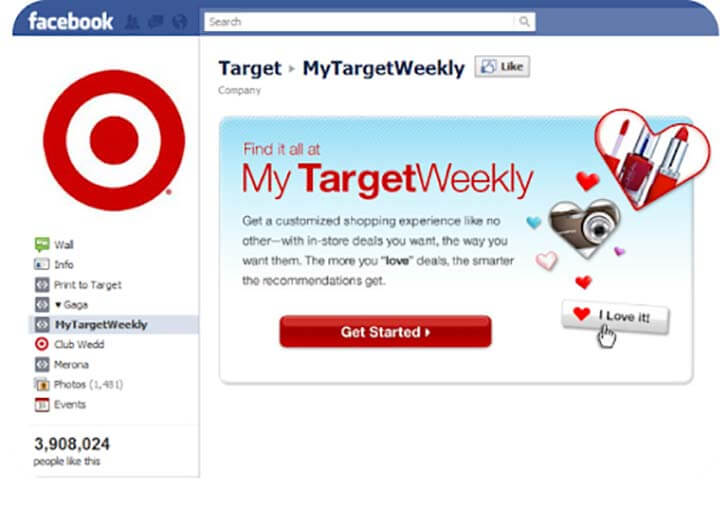
Target STP analysis
The STP analysis of Target Corporation is performed as follows-
Target Segmentation
The market segmentation of Target Corporation is performed as follows-
| Segmentation | Segmentation criteria | Customer groups |
|---|---|---|
| Geographic | Region | USA |
| Density | Urban and rural | |
| Demographic | Age | 18 to 50 years |
| Gender | Both male and female | |
| Occupation | Students, employees, professionals, senior managers, etc. | |
| Income level | Middle to high-income group people | |
| Psychographic | Social class | Middle to upper class |
| Lifestyle | Aspirer, explorer, reformer, and succeeder | |
| Behavior | Benefits | Easy accessibility, online shopping and fast delivery |
| User status | Non-users, first-time users, potential users, and regular users | |
| Personality | Determined, ambitious and self-esteemed |
Target market of Target Corporation
The target market of Target Corporation includes middle to high-class people having a household income of more than $20,000. The median age of customers of Target Corporation is 40 years and the company majorly targets young customers through a wide range of essential products.
Positioning of Target
Target Corporation is an upscale discount retailer that is known for offering high-quality and on-trend merchandise to customers at low prices. The company is also positioned for guest-friendly and clean stores of Target Corporation.
Target Consumer analysis
The major customers of Target Corporation include the customers in the Esteem category based on the Maslow hierarchy theory. The consumers of Target Corporation mainly look for trendy and Stylish clothing, household furniture, and other items at a discounted rate. However, the younger generation and women are major customers of Target Corporation.
Recommendations for Target
Our strategic recommendation for Target Corporation is to improve the advertising and promotion strategies to improve the overall brand image and competitive image. The company should also implement in-store advertising campaigns to promote its products and services. Further, the demand for the organic product is rising in the current times which also require the company to launch various in-store and outdoor advertising strategies to promote its organic products. Along with this, the competitor analysis of Target Corporation also helped to determine that the prices charged by Target Corporation are still higher than the prices charged by Amazon and Walmart. Thus., it is suggested that the company should reduce its prices of the goods to further attract a large number of customers. Not just this, it is also found that Target Corporation should also improve its online delivery of goods to improve its competitive position. The use of various technologies such as robotics, drones, etc. will help the company to ensure faster and easy delivery of goods.
Conclusion
From the above strategic analysis, it is found that Target Corporation is one of the leading American retail companies that has established a strong brand image in the industry due to affordable pricing Strategies and diversified product lines. The external analysis of the company helped to determine that demand for retail products is rising in current times due to the increasing population and changing buying behavior of the customers. It is found that digital marketing and online shopping have gained significant importance in the current times. Hence, it is recommended that Target Corporation should focus on improving its online delivery services through the use of various technologies to ensure faster delivery of the goods to the customers. Moreover, it is also determined that the company should implement in-store advertising campaigns to promote Organic products in the market.
Further readings
References
- Allianceexperts. (2021). United States retail industry: business opportunities and tips. alliance experts. Retrieved 1 September 2021, from https://www.allianceexperts.com/en/knowledge/countries/america/chances-in-the-us-retail-industry/.
- AMADEO, K. (2021). US Retail Sales Report July 2021. The Balance. Retrieved 1 September 2021, from https://www.thebalance.com/u-s-retail-sales-statistics-and-trends-3305717.
- Bhasin, H. (2018). Top 10 Target Competitors. Marketing91. Retrieved 2 September 2021, from https://www.marketing91.com/target-competitors/.
- Christman, C. (2013). Target’s Perfect Marriage of Traditional and Digital Marketing. Mainstreethost. Retrieved 2 September 2021, from https://www.mainstreethost.com/blog/targets-perfect-marriage-traditional-digital-marketing/.
- Corporate. (2021). 2020 Annual Report Target Corporation. Corporate.target.com. Retrieved 2 September 2021, from https://corporate.target.com/_media/TargetCorp/annualreports/2020/pdfs/2020-Target-Annual-Report.pdf.
- Cox, J. (2021). U.S. GDP rose 6.5% last quarter, well below expectations. Retrieved 1 September 2021, from https://www.cnbc.com/2021/07/29/q2-gdp-rises-at-6point5percent-vs-8point4percent-estimate.html.
- Csi. (2021). Target Corp's (TGT) Suppliers by Company, Division and Industry - CSIMarket. Csimarket.com. Retrieved 2 September 2021, from https://csimarket.com/stocks/suppliers_glance.php?code=TGT.
- Eeoc. (2020). Target Corporation to Pay $45,000 to Settle EEOC Disability Discrimination Lawsuit | U.S. Equal Employment Opportunity Commission. Eeoc.gov. Retrieved 2 September 2021, from https://www.eeoc.gov/newsroom/target-corporation-pay-45000-settle-eeoc-disability-discrimination-lawsuit.
- Fortune. (2021). Target Company Profile | Fortune. Fortune. Retrieved 1 September 2021, from https://fortune.com/company/target/.
- Imrg. (2021). Legal issues within retail in the USA - IMRG. Imrg.org. Retrieved 2 September 2021, from https://www.imrg.org/usa-legalities/.
- KUANG, C. (2020). The Top Rivals of Target. Investopedia. Retrieved 2 September 2021, from https://www.investopedia.com/ask/answers/051915/who-are-targets-tgt-main-competitors.asp.
- Lee, Y. (2020). These 6 charts compare the US and China economies in the second year of their trade war. cnbc. Retrieved 1 September 2021, from https://www.cnbc.com/2020/01/02/trade-war-6-charts-comparing-us-china-economies-and-markets-in-2019.html.
- Macrotrends. (2021). U.S. Population Growth Rate 1950-2021. Macrotrends.net. Retrieved 1 September 2021, from https://www.macrotrends.net/countries/USA/united-states/population-growth-rate.
- MINNEAPOLIS. (2021). Target Outlines Commitment to Environmental Sustainability. Target Corporate. Retrieved 1 September 2021, from https://corporate.target.com/press/releases/2010/12/target-outlines-commitment-to-sustainability.
- MINNEAPOLIS. (2021). Target Builds on Momentum, Announces 2021 Strategic Investments. Target Corporate. Retrieved 2 September 2021, from https://corporate.target.com/press/releases/2021/03/Target-Builds-on-Momentum-Announces-2021-Strategic.
- MIRZAYEV, E. (2019). Walmart vs. Target Business Model: What's the Difference?. Investopedia. Retrieved 2 September 2021, from https://www.investopedia.com/articles/active-trading/070715/target-vs-walmart-whos-winning-big-box-war.asp.
- Pratap, A. (2021). Business Model of Target Corporation. notesmatic. Retrieved 2 September 2021, from https://notesmatic.com/business-model-of-target-corporation/.
- Samuel. (2021). Target Mission Statement, Vision & Value Analysis | How I Got My Job. How I Got My Job. Retrieved 1 September 2021, from https://howigotjob.com/mission-statement/target-mission-and-vision-statement-value-analysis/.
- Smith, C. (2015). Target undercuts its competitors on free shipping requirements. Business Insider. Retrieved 2 September 2021, from https://www.businessinsider.com/chart-target-undercuts-its-competitors-on-free-shipping-requirements-2015-2?IR=T.
- Target. (2021). Target Corporation | History & Facts. Encyclopedia Britannica. Retrieved 1 September 2021, from https://www.britannica.com/topic/Target-Corporation.
- Ustr.gov. (2021). Afghanistan | United States Trade Representative. Ustr.gov. Retrieved 1 September 2021, from https://ustr.gov/countries-regions/south-central-asia/afghanistan.
